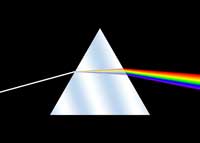Physics in the Snow: Snowy Colors
Most people associate Ben Franklin with electricity, but his first recorded experiment was on something totally different – color and heat. You’ve probably noticed that you heat up faster in the sunlight if you’re wearing a dark shirt. Try this activity to find out why.
What you Need
- Baking pan
- Different colors of felt (black, white, and green are a good mix)
- Snow (or ice shavings)
- Sunshine
What to Do
- Bring a baking pan outside and fill it with snow (or ice shavings). Level off the top.
- Place the different colors of felt directly on the snow (you may need to cut them down so they all fit). There should be at least an inch of space between each piece of felt.
- Let the pan sit in direct sunlight for a while and check on it every half hour or so. What happens to the snow? Which colors sink into the snow first?

What’s Going On?
This was Franklin 's first experiment – to observe the effect of color on an object's heating rate. Franklin found (as you should have) that dark-colored objects sink faster and farther in the snow than light-colored objects. This means that the snow under the darkest colors of felt melts the fastest. This led Franklin to the conclusion that dark-colored objects heat faster than light-colored objects.

An illustration of Franklin 's results.
Sunlight looks white or yellow, but it is actually made up of all of the colors of the rainbow. Raindrops and prisms can split sunlight into these colors.

A prism can be used to split white light into its component colors. Image licensed under Creative Commons ShareAlike 1.0
Black objects don't reflect any light. They absorb all of the light that falls on them. By contrast, white objects reflect all colors of light and don't absorb any. Green objects fall somewhere in the middle. Dark red objects absorb more light than light red objects. In general the darker the color, the more light is absorbed and the less is reflected.
What does this have to do with heat? Heat and light are both forms of energy. Most of the light that objects absorb turns into heat. Since black objects absorb the most light, they also give off the most heat.
*From now on the term “light” refers to visible light.
Try This!
- Repeat the experiment but instead of using different colors of the same material, use different materials that are all the same color. Which materials give off the most heat?
- Devise a similar experiment to test which color cools the fastest.
More Information











